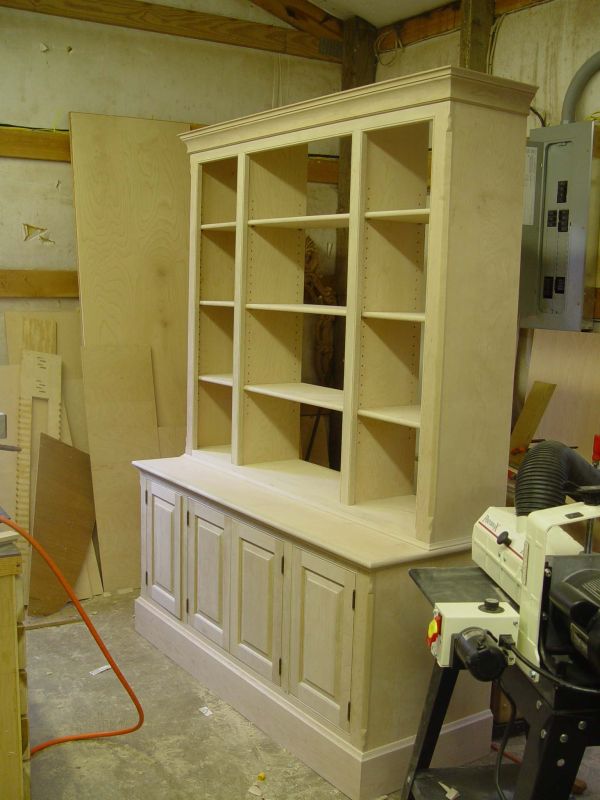Both Sides, Now
Ideas for jigs and fixtures that allow finishing and drying on both sides of the same panel. February 8, 2005
Question
I have thousands of closet end panels (24 x 87) to finish on both sides. I am looking for a clip to mount to an end that will allow two-side finishing prior to setting in a conventional rack for finish drying. This is a one shot deal - I am not looking for a tunnel with a hanging track.
Forum Responses
(Finishing Forum)
From contributor R:
How about screwing a cleat wider than the panel is thick to each end? That way you can stack 'em and the cleats will keep the panels apart while they dry. If you make the cleats longer than the panel is wide, you have handles to move the panel while wet. A little forced air across the stack will speed up the drying time, too. Unscrew and reuse cleats for next set once panels are dry.
From contributor J:
Why not spray them standing up with only the back corner touching wall of booth and unfinished end/bottom setting on a couple sticks to keep it off the ground? Moving will take two people, but if you maze them up to dry you'll save a lot of time.
From contributor T:
What's a "conventional" drying rack? The ones I'm familiar with would have you putting a face (dry or unfinished) in contact with the supports while the wet face dries. We use cleats with spacers on each end. These support the panel while spraying flat. Then stack vertically against a wall, cleat-to-cleat. I guess with 87" panels you would have a 2-man situation for flipping and moving. I suppose you could spray them leaning against the booth wall so 1 man could flip them and carefully tote them by the top cleat to the drying area (87" is a reach). I would cover the booth walls and floor with approved paper to deal with the amount of wet and built-up overspray, changing as needed.
From contributor Z:
Sometimes it helps to know how these panels will work attached or where exactly the hardware will be attached. I usually use 3" screws in those places. It helps me flip them over or set them upright.
From contributor C:
I'd probably build several racks with v-grooves in the top and bottom rails to slide 4 or 5 panels in each rack at a time. Finish both sides standing up and just let them dry in place.
From contributor H:
We use door carts when spraying doors. You could make a cleat similar to the one we use with our door carts with a steel pin at both ends. You could then set your panels on horses and spray one side, rotate, then spray the other side. You then pick up each panel by the pins and carry them to some large horses where you can stack 20 - 25 of them for drying. The advantage of spraying flat as opposed to vertical is that you can spray many more mils of material without worry of runs. Obviously, it would be better to have carts with wheels so the panels could be easily moved out of the booth by one person.
From contributor L:
I've used a shop-made version of the rack discussed above for staining and spraying solid oak (very heavy) doors. After finishing, I screw feet on them to stand upright to cure. The thing is, it's not a quick process. Mounting the doors and un-mounting them is slow. If your panels are not heavy, how about running 2 long screws or drilling 2 holes in each end and putting rods in to rest across sawhorses? Do one side, flip, do the other side, then they can be laid across two horses to dry. A 4x4 stick laid across each end and you can put the next one on top, as high as you can reach. If you stack them on a lowbed cart, you can wheel them around. This is, obviously, a two person operation.
I have to disagree about spraying them against the booth wall. I've had the experience of chipping off an inch of overspray from a booth wall.
From contributor V:
How thick and how heavy are the panels? To avoid the time of fastening cleats and then removing them, why not dowel hole the ends, insert some rods, shoot them, hang them to dry and then stack them and use the rods on the next set?
For panels similar in dimension to what you have, I shoot them horizontally one face at a time, put them in my panel rack or two Hafele racks put side by side. By the time I finish one side of the rack, the other side is dry enough to flip and finish the other face. But then I'm not looking at shooting 1000 of these, just eight to ten a week while I'm finishing the rest of the kitchens.
From contributor E:
I screw two boards (3/4 ply 20 in long by 3 in wide) on the bottom, stand them on a piece of cardboard and slide them around. Spray them vertically. We also have flat carts with wheels that you can screw the boards down onto and then wheel them in and out of the booth.
The comments below were added after this Forum discussion was archived as a Knowledge Base article (add your comment).Comment from contributor B:
I use a 3 inch screw in the unfinished top and bottom of door, about 1 foot from the end. I spray one side laying flat on sawhorses, then hang and spray the other side. This works great for hollow core doors and is easy to do with one person.
